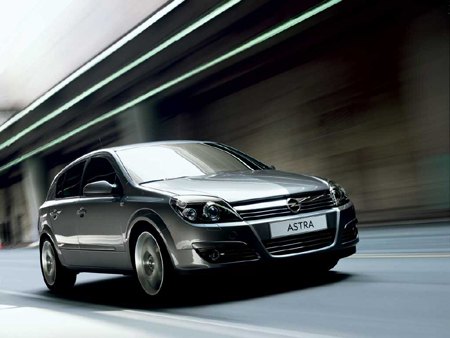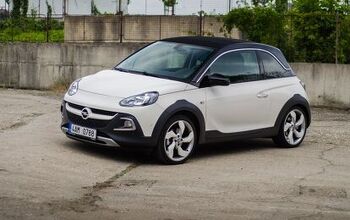Opel Astra Review

When GM suddenly decided it needed a convincing small car for the US market, Car Czar Bob Lutz scanned his European operations and fixed his once-steely gaze on the next gen Opel Astra. Unfortunately, GM’s bean counters confirmed what common sense suggested: labor costs, transportation costs, unfavorable exchange rates and competitive pricing preclude the possibility of profit. Maximum Bob was undeterred, claiming GM will build the “Saturn Astra” in the US if it succeeds (i.e. loses them lots of money). All of which raises an important question: does the Astra have what it takes to sell stateside?
The Astra’s muscular mix of creases and curves will appeal to US buyers who want a small car that looks taut, not tiny. From the front, the car’s oversized headlights and upwards sloping hood fool the viewer into thinking they’re contemplating a full-size sedan. From the side, the Astra’s flared wheel arches and cleverly constructed two-piece rear window give the car sporting symmetry. The model’s odd, bland rear– complete with gun slit rear window– denies viewers a happy ending. But at least it doesn’t look cheap.
If Americans fancy a bit of style, the Astra’s cabin got, er, a bit of style. The central hood crease is the main design element. It continues through the Astra’s windshield, dash and center stack. Ignore this needless affectation and you’re free to enjoy the Astra’s well-judged economy car minimalism. The right-sized steering wheel is reassuringly thick, perfectly shaped for ten and two hand positioning. The gauges are a model of clarity and legibility. And the high touch plastic switchgear snick-snaggles with convincing clicks.
In terms of roominess, the Astra is no penalty box. Although supersized Americans might find the car’s supportive seats overly snug, there’s plenty of head and legroom on offer. I’m 6'3"; I could sit comfortably both fore and aft. Unfortunately, the Astra’s ergonomics are not ideal. The climate controls need color-coding and the mouse's piano of sound-system controls is a annoying distraction. Niggles really, given the interior’s overall quality.
Once underway, I was impressed with the engine’s smoothness, but left wondering how a diesel could be so low on torque. Then I remembered that my tester was powered by an anemic 1.4-liter, 90hp (DIN) gasoline engine. While Opel builds some class-leading motors; my tester’s mill was the weakest and cheapest. And man, was it a stinker. Never mind. All US Astras will holster a 1.8-liter, 140hp Ecotec four-cylinder powerplant connected to either a five-speed manual or a four-speed automatic.
I have a theory about automotive zen: every car has a certain speed at which it feels comfortable. So much for that theory. I didn't know they still built cars that generate 3000rpm at 60mph. At 110mph, with 5700rpm on the clock, the Astra's little engine that could sounded decidedly sweeter. But at that speed, the trip computer told a hysterical tale of 14mpg. Hopefully, the US-spec motor will offer better performance, efficiency and low end sonic civility.
I have a favorite freeway off-ramp where I take my testers for comparison purposes. The Astra’s chassis handled the curve magnificently; it remained stable and balanced from start to finish, with neutrality that belied its front wheel-drive underpinnings. I was able to punt the car through the turn as quickly as any non-sports car I’ve driven– a full five miles per hour faster than I could push the Honda Fit.
On the downside, the Astra’s steering is seriously non-linear. Turn the tiller a bit and you get a predictable response. Add a few more degrees and it’s like you wrenched the wheel sideways. The turn-in is far too abrupt for high speed precision driving— a criticism that's been leveled at the Pontiac Solstice and Saturn Sky. The Astra’s ride quality is also less than impressive, serving up an unappetizing combination of bounce and bang.
The Astra's edgy, non-communicative steering and its ride quality (or lack thereof) killed any autobahn joy. Worse, it delivered unto me another classic Opel "moment" (sooner or later, every Opel I've ever driven has made me curse under my breath). My Astra moment came while doing 100mph, trailed by a pushy BMW, in a series of downhill curves. My mount did a nasty hop-skip over an expander joint. The Astra’s snatchy brakes did nothing to correct the feeling of impending disaster.
With a better engine, the Astra would be a good car. But not great. There’s no doubt that the Astra's dynamics aren't up to par with its VW and [European] Ford competition. Still, the Astra has more character and style than most Asian cars, and it’s better than anything else GM has ever offered in this class. As an Everyman car for Europe, it’s a highly competent entry. As a high-spec, up-priced "European import", it’s destined to be a failure.

More by Martin Schwoerer
Latest Car Reviews
Read moreLatest Product Reviews
Read moreRecent Comments
- Formula m How many Hyundai and Kia’s do not have the original engine block it left the factory with 10yrs prior?
- 1995 SC I will say that year 29 has been a little spendy on my car (Motor Mounts, Injectors and a Supercharger Service since it had to come off for the injectors, ABS Pump and the tool to cycle the valves to bleed the system, Front Calipers, rear pinion seal, transmission service with a new pan that has a drain, a gaggle of capacitors to fix the ride control module and a replacement amplifier for the stereo. Still needs an exhaust manifold gasket. The front end got serviced in year 28. On the plus side blank cassettes are increasingly easy to find so I have a solid collection of 90 minute playlists.
- MaintenanceCosts My own experiences with, well, maintenance costs:Chevy Bolt, ownership from new to 4.5 years, ~$400*Toyota Highlander Hybrid, ownership from 3.5 to 8 years, ~$2400BMW 335i Convertible, ownership from 11.5 to 13 years, ~$1200Acura Legend, ownership from 20 to 29 years, ~$11,500***Includes a new 12V battery and a set of wiper blades. In fairness, bigger bills for coolant and tire replacement are coming in year 5.**Includes replacement of all rubber parts, rebuild of entire suspension and steering system, and conversion of car to OEM 16" wheel set, among other things
- Jeff Tesla should not be allowed to call its system Full Self-Driving. Very dangerous and misleading.
- Slavuta America, the evil totalitarian police state






































Comments
Join the conversation
As I see complaints of "Dull interior", "Dull Handling", "Dull Engine" etc. I think "Well, You get what You pay for". The 1.4 engine is meant for the Very Low income part of Europe and pensioners (60+). It's got good economy, handles well (You don't pass 60/70 mph in the 1.4) and won't cost much too buy. Remember that The price of Gas in Europe is mostly much higher than the US ($ 6.80 pr. 1 US Gallon here in Norway). And the Astra 1.9 CDTI (200bhp tuned, NavSat, IDS+ Active Suspension, 18" Summer/17" Winter, Leather interior and more) cost me 370' NOK (which is about $61000, yes sixty one thousand US dollars). Generally the VW Rabbit/ Ford Focus costs a $2000-$3000 more for an equally equipped car. The Audi A3 and BMW 1 would cost You $10000 more for an equally equipped car. You pay a lot for Brand snobbery in Norway, but it doesn't give You a higher quality car. If You consider this, MPG is important. I don't need 6 Cyls+ and a large engine. I need a small engine (1.9) with lots of power (200+bhp) and torque (440 NM) that delivers 60+MPG when I drive long trips and that has very low emissions (CO2/NoX/Soth). Now, considering that "Diesel" isn't a sales-pitch in the US (therefore the "BlueTec" name from MB/BMW) I say: Your loss!! I'm never going back to Gasoline again. The new Diesel-generations is about to eliminate Gaz. in Europe. I'm sure we'll see a Porche 911-xxx with Diesel in the short future....
I have one of these booked for my annual break near the med next week. No model specified but I expect it will be the base "Bill & Doris" 1.4 poverty spec special with A/C tacked on. I had its MPV brother, the Zafira, last year. It was very good apart from the combination of hefty Americans and the 1-in-3 entrance to the villa - it snapped an engine mount on week 2. Went well for a 1.7 Diesel though. The Estate (wagon) is the looker though.